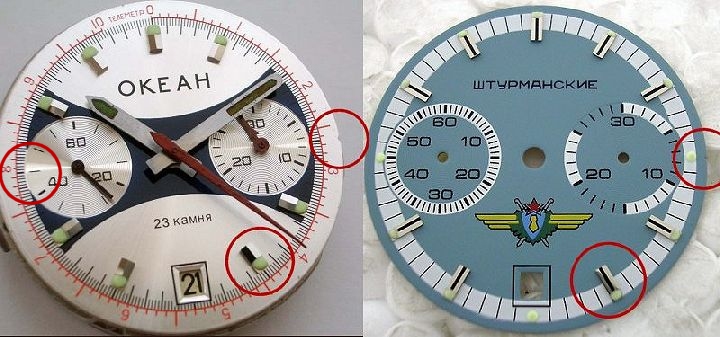Determining the Age and Originality of a Poljot cal. 3133 Chronograph
Two of the most challenging aspects of collecting Poljot chronographs are determining their age, and whether or not they are in original form. I have always been amazed at how little information is available in regards to dating these watches. This is especially true of the early chronographs produced during the Soviet era, where hard evidence indicating year of production as well as catalogues are few and far between. So here's hoping this guide will help all those interested in determining the age and originality of a Poljot chronograph.
A 3133 Chronograph appears on the front cover of Poljot's 1982 Catalogue:
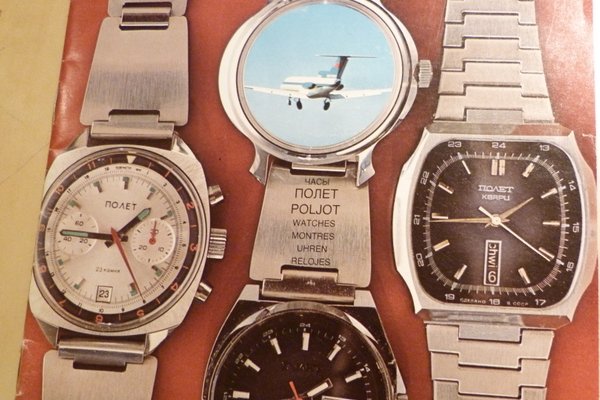
Unfortunately, I will not be able to add sufficient information to allow you to pinpoint an exact year of production during much of the Soviet era. However, after cross-referencing a chronograph with the following information, you should be able to narrow the age down to within a few years. In most cases, you will have to rely on more than just one element to determine a) the approximate age of the chronograph, b) whether or not it has been repaired at some point, and c) whether or not it has been frankened together using available parts. In addition, you can expect to see a replacement part or two on many of the older chronographs that can confuse the dating process.
I would welcome any information that would help identify the age of a particular early model chronograph, and I will be happy to make changes/updates when necessary. However, if you have previously posted information about dating a 3133, or have posted images of a 3133 movement, I have more than likely already viewed it and taken it into consideration - and thank you for that. What we need now is hard-evidence such as a chronograph with papers from the late '70s or early '80s. Even circumstantial evidence such as Dad or Grandpa "received this watch in 1980 while serving in the military" or "when visiting the Soviet Union", or possibly an engraving that indicates the latest possible production date. Again, if it's already "out there", I've probably seen it.
The majority of watches and photographs in the following presentation are from my own collection. However, my conclusions are by no means based on my collection alone. I am simply using my own images, whenever possible, to avoid having to make numerous and sometimes impossible requests. Thanks to those who have, unknowingly, provided images for this presentation, as I have no record of where I copied them from.
Evolution of the Poljot cal. 3133
This section can be used as a quick-reference in conjunction with the rest of the guide, where images related to the following information are available.
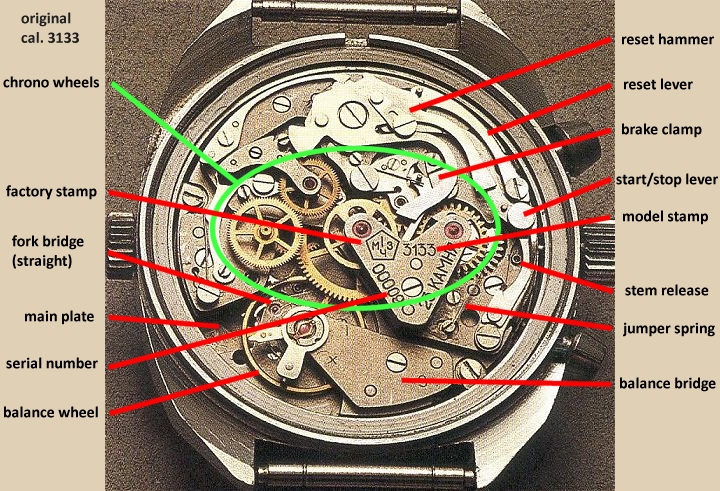
The following is list of the oldest known cal. 3133 chronographs in what is believed to be the correct chronological order:
Crown Stamp #1
- 00520 - brake clamp (YES), straight bridge (YES) Timepiece Tenderfoot
- 00631 - brake clamp (YES), straight bridge (YES) Ham2
- 00638 - brake clamp (YES), straight bridge (YES) MrKilla
- 00775 - brake clamp (YES), straight bridge (YES) Marc Delcorps
- 00842 - brake clamp (YES), straight bridge (YES) Unknown Owner
- 01622 - brake clamp (YES), straight bridge (YES) Ham2
- 01736 - brake clamp (YES), straight bridge (NO) polmax3133
- 01925 - brake clamp (YES), straight bridge (YES) polmax3133
Crown Stamp #2
- 02721 - brake clamp (YES), straight bridge (YES) eBay seller
- 05679 - brake clamp (YES), straight bridge (YES) Boris
- 03187 - brake clamp (NO), straight bridge (NO) slls
- 03639 - brake clamp (NO), straight bridge (NO) Unknown owner
- 03901 - brake clamp (NO), straight bridge (NO) polmax3133
- 03947 - brake clamp (NO), straight bridge (NO) 103ssv
- 05216 - brake clamp (NO), straight bridge (NO) Ham2
Crown Stamp #3
- 4-digit serial numbers
ca. 1975
The earliest cal. 3133 prototypes feature the old 1MWF (1st Moscow Watch Factory) “pentagon” stamped on the chronograph bridge.
Initial production/prototypes also featured:
- Gold-coloured chronograph wheels.
- Single slot reverse-threaded lever bolts.
- Block-style serial number font.
- Straight-edged pallet fork bridge.
- A two-piece bolt and clamp method of securing the chronograph brake.
- Steel-coloured jumper spring.
- 5-digit serial number.
- Solid winding-stem release button.
- Two-piece reset hammer.
- Brass balance wheel.
ca. 1976
Features removed immediately before early limited production were:
- 1MWF pentagon stamp replaced with Poljot crown (version #1).
- Gold-coloured chronograph wheels replaced with steel-coloured wheels.
- Single slot reverse-threaded lever bolts replaced with tri-slot bolts.
ca. 1977
The first visible upgrade to the cal. 3133 were:
- An easy access slot cut out of the pallet fork bridge.
- Poljot crown stamp (version #1), on the chronograph bridge, replaced with a more refined and smaller Poljot crown (version #2).
- New-style serial number font.
- The two-piece bolt and clamp method of securing the chronograph brake is replaced by a single bolt.
ca. 1979
Poljot ceases production or the cal. 3017
- Third version of the Poljot crown (version #3) closely resembles the initial (version #1) but with refinements.
- New 4-Digit serial numbers reflect limited yearly production.
- Steel-coloured jumper spring replaced by new brass-coloured spring.
ca. 1980
Solid winding stem button replaced by hollowed-at-tip version
ca. 1981
Poljot crown removed from chronograph bridge and replaced by a much smaller crown on the main plate beside the escape mechanism.
ca. 1982
Chronograph running wheels begin transition to new gold-coloured wheels.
ca. 1983 - Q2-1986
No changes.
ca. 1986
Begin production of new Sturmanskie aviators' chronograph w/grey dial.
Q2-1986
Single piece reset hammer introduced.
ca. 1987
New thin-style number font on date ring.
ca. 1988
Poljot employs approx. 6000 people.
ca. 1989
New 5-digit serial number reflects higher yearly production.
Q3- 1990
Model number stamp on chronograph bridge (“3133”) changed to “SU 3133” version #1.
Dec. 1991
Dissolution of the Soviet Union.
ca. 1992
Poljot becomes a joint-stock company. Without a competent global marketing strategy, and competitive products to go along with it, the company is unable to compete in a free-market. Asian and Swiss produced watches are able to obtain much of the domestic market, and with state subsidies severely reduced, Poljot begins to decline.
Alexander Shorokhov establishes Poljot-V GmbH, a company that imports and distributes Russian watches in Germany.
Q2-1992
Brass balance wheel changes to new silver-coloured alloy.
ca. 1993
Model number stamp on chronograph bridge (“SU 3133”) changed to “SU 3133” version #2.
1994
Basilika chronograph produced for the first time.
1995
Poljot-V changes it’s name to Poljot-International
ca. 1996
Russian Government initiates bankruptcy proceedings against Poljot.
- “SU” prefix removed from model number stamp on chronograph bridge.
- Golden-coloured chronograph wheels begin to be replaced by yellow-coloured wheels; a slow process that would take until after the turn-of-the-century.
ca. 1997
Poljot scales down operations and cuts back on equipment upgrades in order to pay back debt.
- New “P3133” model stamp replaces the old “SU 3133” and “3133” stamps.
- New “MADE IN RUSSIA” balance wheel bridge stamp introduced.
- Cheaper quality adjustment cams fitted.
ca. 1998
Poljot total production at 145,000 units.
ca. 2000
- Poljot total production at 300,000 units.
- The company Volmax is formed under the Poljot umbrella to initiate and oversee the creation of new designs and collections.
- A distribution network strategy in put in place.
- Chronograph quality is improved with the introduction of stainless steel cases.
- New complications are added to the cal 3133 chronograph including moon phase, 24hr, and day/night indicators creating the new calibres 31679, 31681, and 31682 respectively. On some models, a special day/night window stamp, that looks somewhat like a Euro currency symbol, was prefixed to model number stamp in place of the “P“ prefix.
- Although the Poljot debt is now repaid, much of the equipment used to manufacture the watches is now hopelessly out-dated.
2002
Final Poljot catalogue released.
2003
- One Hundred Years of Aviation / Wright Brothers collection released.
- First Strela branded chronographs released.
2004
- Poljot is fully privatized.
- Final year of Poljot cal. 3133 production.
- Volmax catalogue released.
2005
- The company MakTime purchases the cal. 3133 chronograph production line from Poljot and move the machinery it to it’s factory in the south-east end of Moscow (completed in June).
- The “MADE IN RUSSIA” stamp on the balance assembly bridge is no longer applied.
- Presumably, at this point in time, the Poljot crown stamped on the main plate is replaced by the MakTime logo.
- Poljot cuts annual production from 500,000 to 60,000 units.
- The Poljot factory now employs only 275 people.
- 75th anniversary Poljot Journey chronograph released.
2006
Poljot branded “ROSSI” collection of watches marketed.
ca. 2010
A “C” prefix replaces the “P” prefix on some cal. 3133 movements fitted to the Strela line of chronographs produced for, and distributed by, Juri Levenberg and cooperative dealers.
The Balance Wheel and Bridge
By the beginning of 1993, all Poljot Chronograph movement are fitted with a new silver alloy balance wheel. Checking the balance wheel is a quick way of determining which side of Q4-1992 a Poljot chronograph is on. However, there's always the chance that a well worn chronograph from the '80s has been retrofitted when serviced.
A "Made in Russia" in '92 chronograph with brass balance wheel:
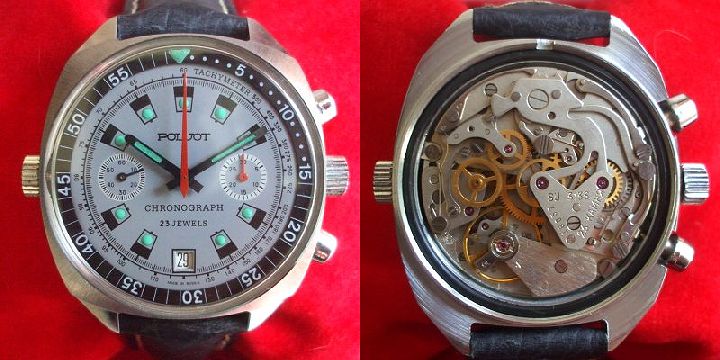
A NOS "Kosmos-1992" with brass balance wheel:
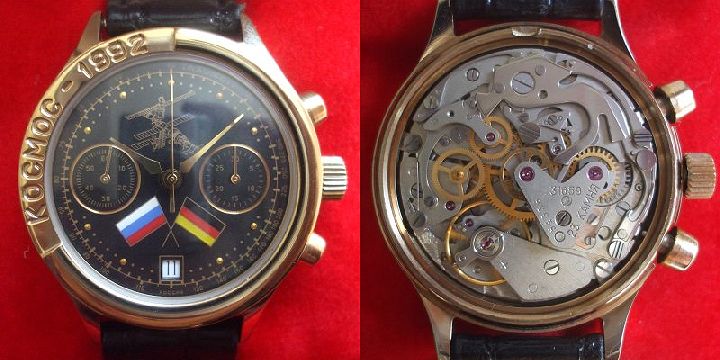
A NOS "Space'92" tagged June, 1993 with a new silver alloy balance wheel:
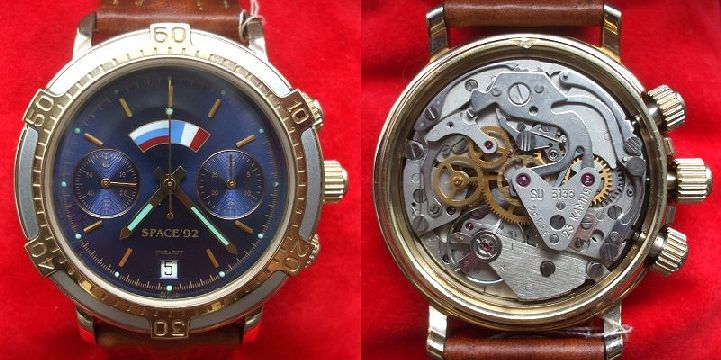
A "MADE IN RUSSIA" stamp appeared on the balance wheel bridge between 1997-2004:
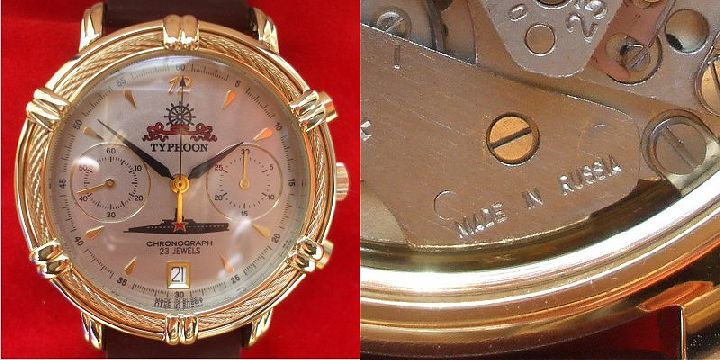
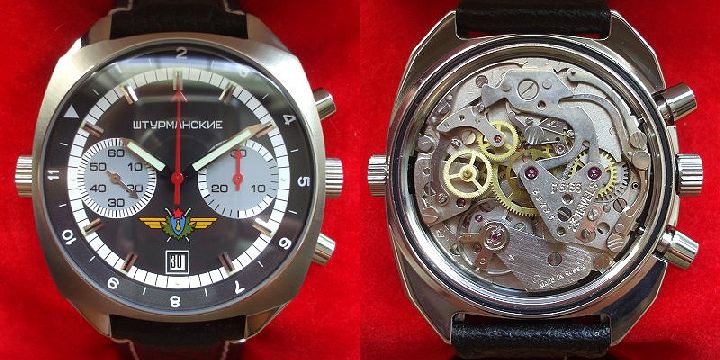
The Chronograph Wheels
A switch from silver to gold coloured chronograph wheels took place ca. 1983 - around the same time the chronographs became available to the public. Often you will see a mix of silver and gold chronograph wheels due either to repair or franken-work. See examples of both versions in the images below.
Chronograph Bridge Stamps - Model Number Stamp
The Initial Model Stamps - 1976-1990
EDIT: It has now been proven that the initial model stamp font was OCR-A. Based on the very limited numbers that I have seen to date(one in my collection, and at least one other), and the low serial numbers, I would guess that this initial version was produced for a maximum of one year. See image below and "Movement Serial Number and Poljot Crown" section for more details:
Font type: OCR-A

Font type: OCR-B

Note that on the "3" the open end of the top bar extends out equally as far as the open end of the bottom bowl.
Early Poljot 3133 chronograph:
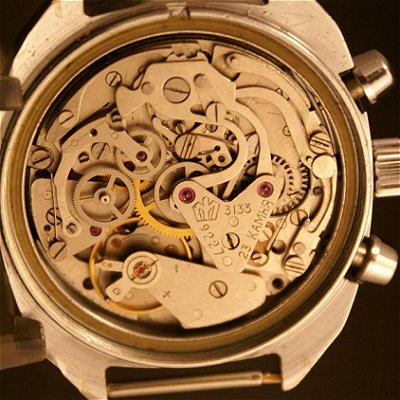
Late Soviet era Poljot Chronograph 1990:
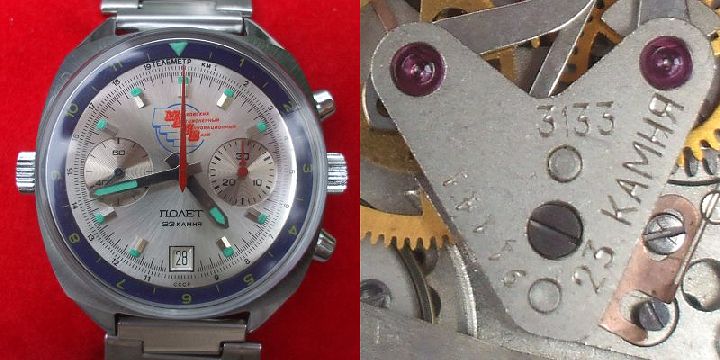
Second Model Stamp early-"SU 3133" - 1990-1993
An "SU" is prefixed just prior to the break up of the Soviet Union.
Font Type: OCR-B

A late Soviet era early-"SU 3133" stamp 1991:
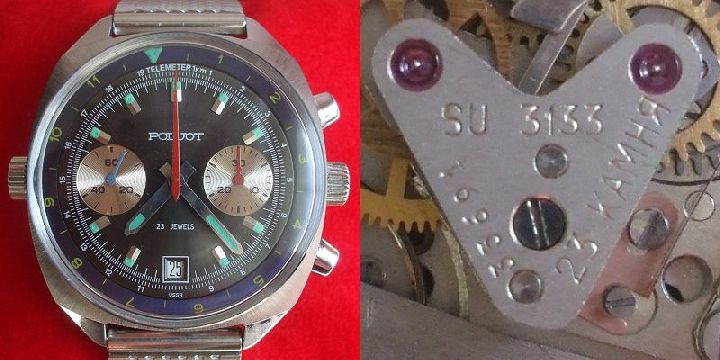
A Russian early-"SU 3133" stamp 1992:
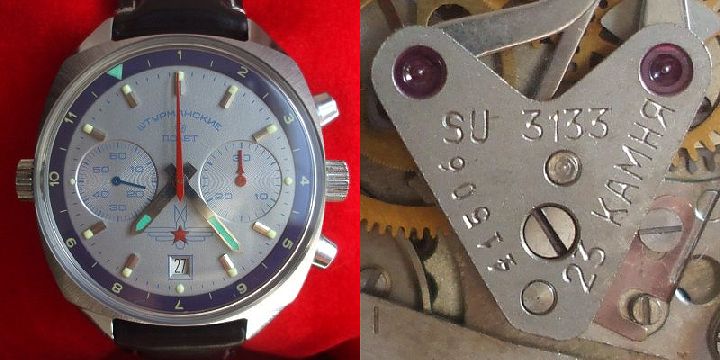
Frankenmakers will fit this movement to an original or reproduction '80s dial because it has the "SU" stamp, and in most cases a brass balance wheel. Later model movements are also fitted with fake bridge stamps and brass balance wheels:
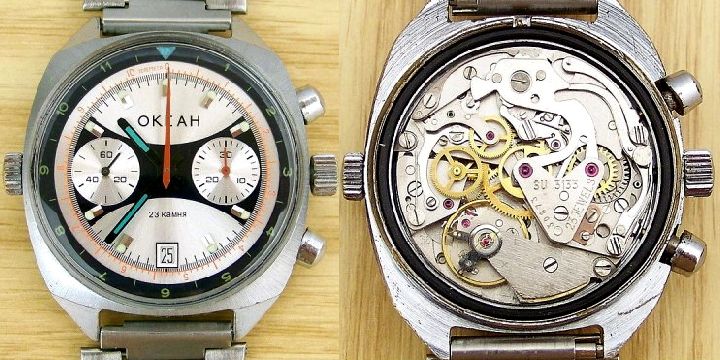
Having cross-referenced the above chronograph with the information in this document, one should be able to conclude that this is the ultimate 3133 frankenchrono.
- The bridge stamp has been faked - "23 JEWELS" in latin on a so-called '80s OKEAH?
- Different era bridge stamp - "SU 3133" on an '80s OKEAH?
- "SU 3133" + "23JEWELS" (in latin) never happened.
- The dial is a reproduction, the hands are wrong...
Just about everything about this watch is not right. The movement is a late-'90s fitted with brass balance and faked chrono bridge stamp. And here's the kicker... it can be all yours for the "Buy It Now" price of $625US!
Third Model Stamp late-"SU 3133" - 1993-1995
The font-type is a bolder modification of the previous stamp.

Note that: A)On the "3", the open end of the bottom bowl extends out further than the upper bar. B)The right stem of the "U" is leaning slightly to the left.
NOS "Space'92" tagged June, 1993 with late-"SU 3133" stamp:
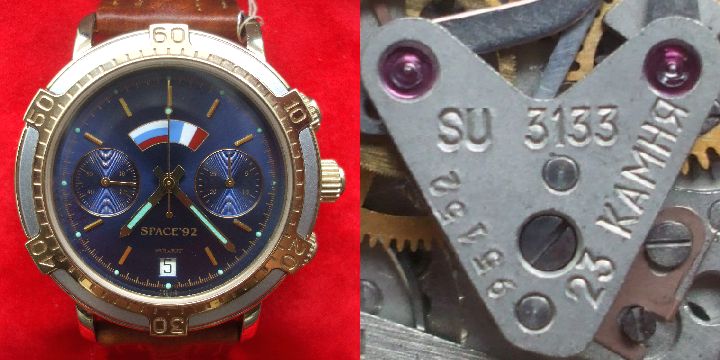
NOS "Kosmos 1994-1996"" with late-"SU 3133" stamp:
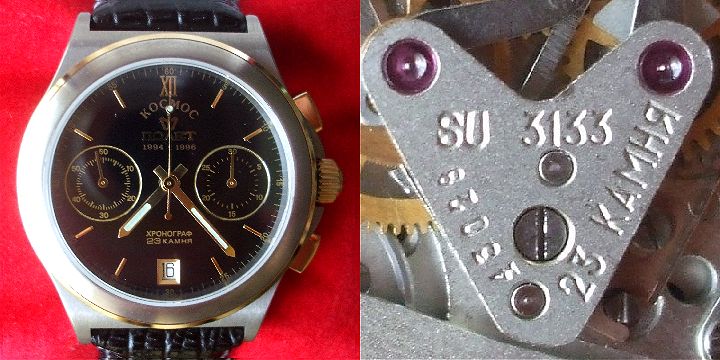
Forth model stamp - 1995-1997
The "SU" is removed prior to the 1996 Olympics in Atlanta, Georgia, USA. A coincidence? Maybe. Poljot produced numerous commemorative watches for the 1996 Olympics.

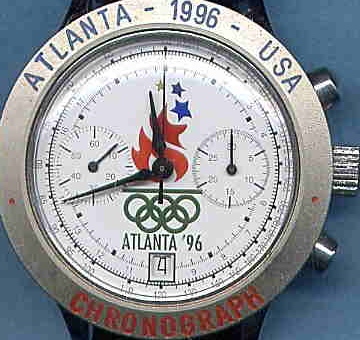
NOS Poljot "Body Guard" 1996:
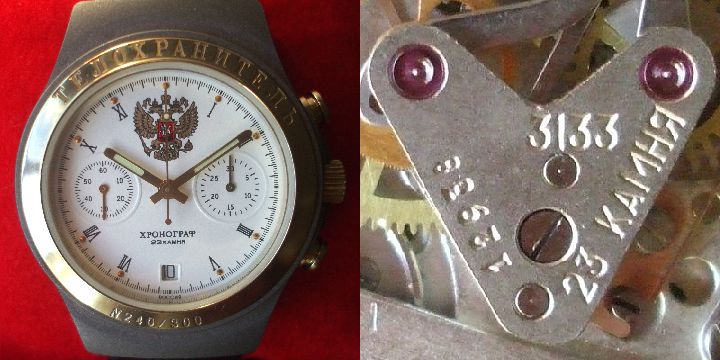
Poljot "Casino" 1997:
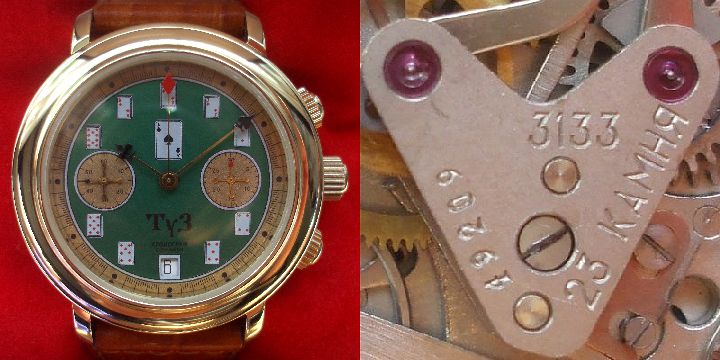
Fifth model stamp - 1997-present-day
A new stamp with a "P" (which presumably stands for "Russia") prefixed to a bolder version of the original style number font.

NOS Poljot "Alpha Group Sniper" 1997:
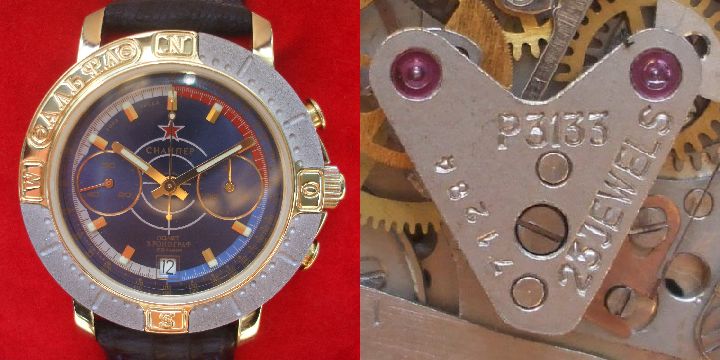
Aviator with MakTime 3133 assembled in 2010:
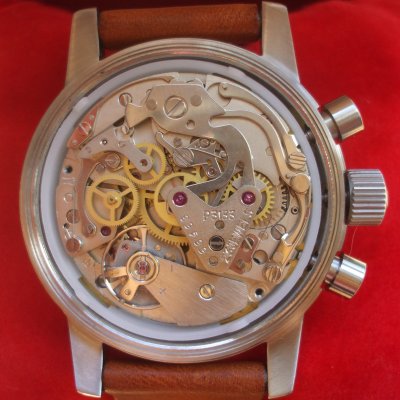
Late model Strelas by Juri Levenberg have a "C"(for Strela) preceeding the model number:
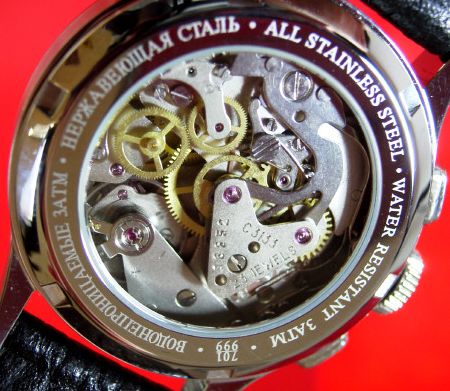
Chronograph Bridge Stamps
"23Jewels" Stamp
A conversion from Cyrillic to Latin on the "23JEWELS" stamp was introduced with the "Fifth model stamp - 1997-present" (see above).
Movement Serial Number and Poljot Crown
EDIT: I have aquired what I believe to be the initial version of the Poljot cal. 3133. The main indicators are a) the Valjoux-style mounting of the break lever with a clamp/lid and bolt instead of the just a bolt, b) the 5-digit serial number with initial OCR-A font, and c) the silver coloured jumper spring. See images below:
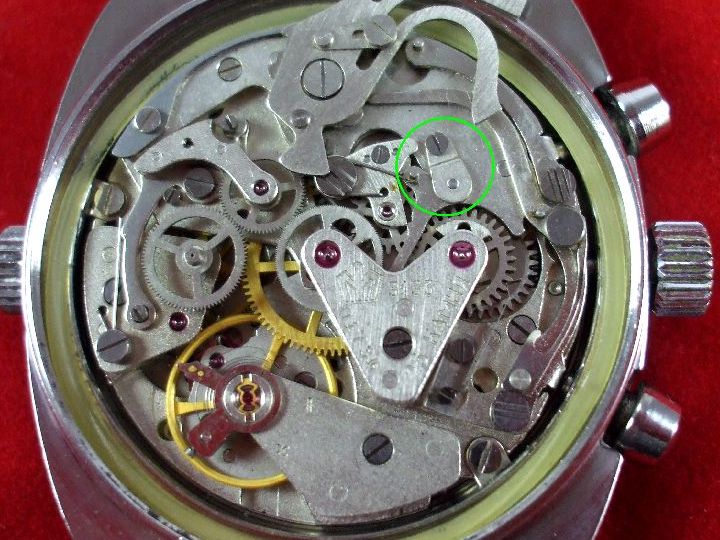
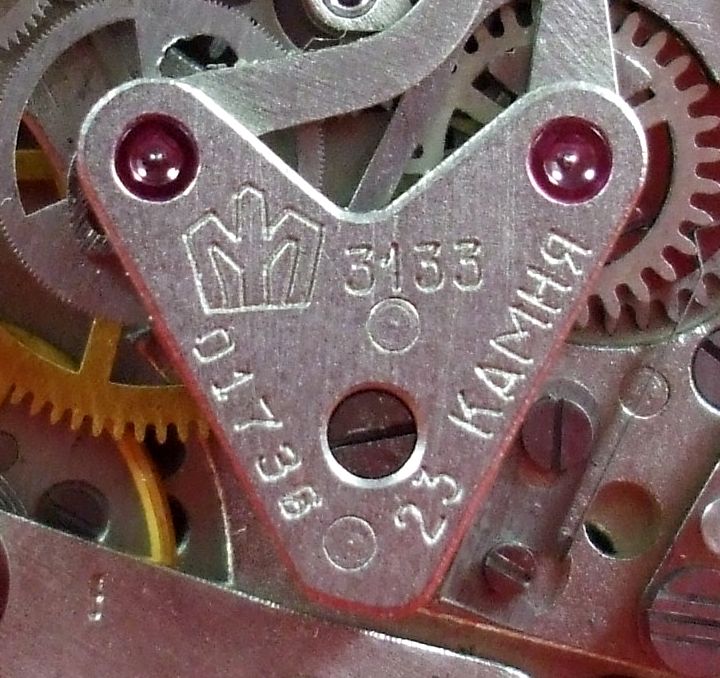
Possibly one of the early prototypes produced before the Poljot Crown was adopted (ca. 1975). Again, the bolt plus clamp mounts the brake lever:
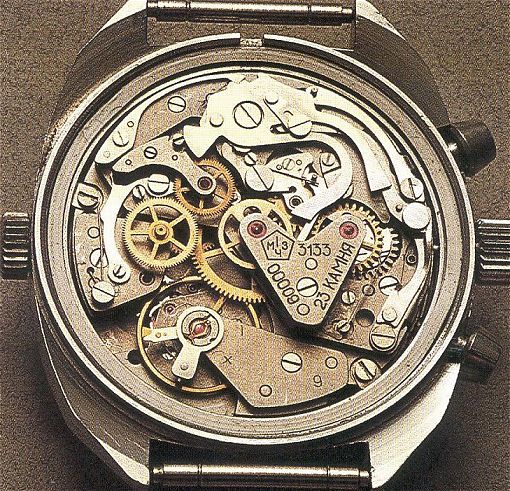
Another movement with all of the early model features:
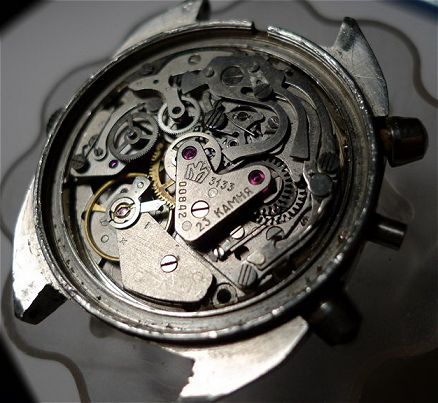
It has also been discovered that an additional two Poljot crown chronograph-bridge stamps followed the original version pictured above. Initially, two of the three stamps were believe to be identical, however, upon closer examination it's evident that there are subtle differences and therefore a total of three separates stamps. The image below illustrates the subtle differences in the original and final version of this stamp, and what is believed to be the go between Poljot crown stamp (center) used up until the 4-serial number was introduced.

Based on available serial numbers, both versions that followed the original are likely to have been produced in far greater numbers.
Assuming that the top of the chronograph bridge is where the jewels are located, for the vast majority of Poljot chronographs we are use to seeing a 4 or 5 digit serial number rotated counter-clockwise approximately 120 degrees from the normal horizontal position - with the lower part of the numbers being closest to the centre of the chronograph bridge. The top of the number is to the left, and the bottom is to the right. Some of the earliest models, however, are a mirror image of this with the top of the numbers being closest to the centre of the chronograph bridge(Image 1).
There are more than a few examples of this.
Also, note the head of crown/stem release push button on all of these movements is protruding instead of being machined hollow. Want to know if you have an early Poljot chronograph movement? Check this button!
Image1:
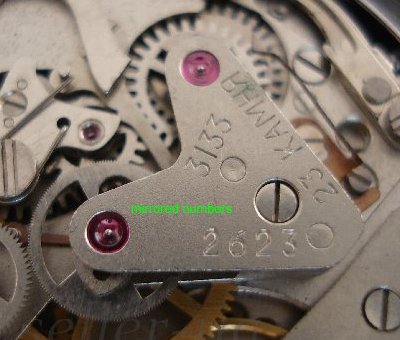
Image2:
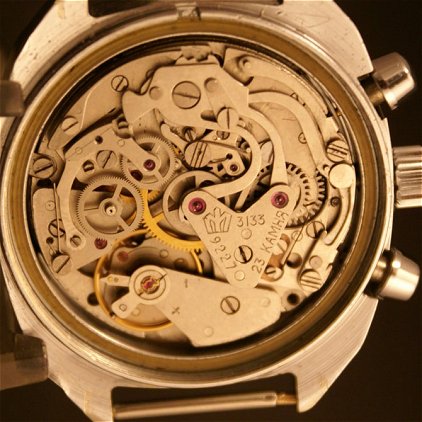
Image3:
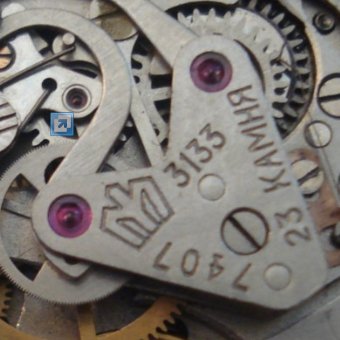
Image4:
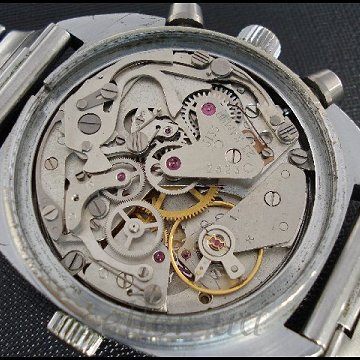
EDIT: Below is another version with the protruding crown release button on the movement. This version has the crown stamp on the main body of the movement, indicating that is the newest version of the early 3133 chronograph movements. The chronograph is very similar to the one pictured in the 1982 catalogue(see above).
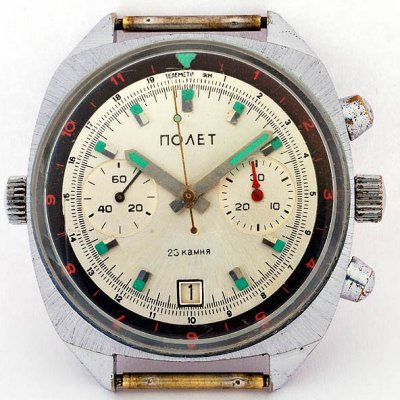
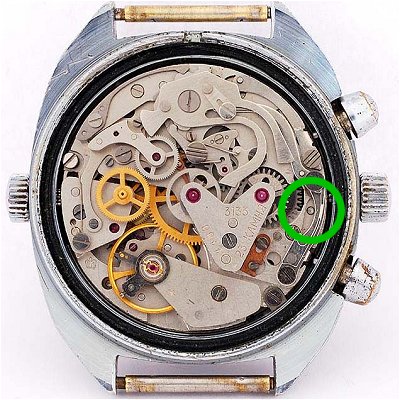
Some versions have the Poljot crown stamped on the bridge(2,3), and some do not(1). Also note than neither of the above examples has a Poljot crown stamped on the main body of the movement.
Now, the question is which of the bridge stamp variations came first?
The most logical explanation would be the initial bridge stamp had the mirrored serial number without the Poljot crown(1); followed by version two which had a Poljot crown added(2); then version three with the cast about modern application of the serial number with crown(3); and then version four with the crown eliminated from the bridge stamp and placed on the main body beside the balance wheel as seen below.
Of course, this is just my own theory. However, any other scenario would involve an extra flip-flop of the serial number at some point.
Whatever the case may be, the lack of a Poljot crown on the main body of the movement, and the protruding stem release button head, are the two common properties that enable you to date a movement to the early years of production. Plus, if you were to take into account serial numbers on the high side of 5000, it's not hard to imagine movements with these bridge stamps running into the early '80s. According to a few sources, production of the 3017 chronograph was approximately 5000 unit per year, and there is no reason to believe it was much higher for the pre-1989 3133 chronographs. Again, if anyone has some hard evidence--I'd love to see it!
Moving on from the so-called military-issue period, the only change of significance made to the serial number was in 1989 when it was changed from a 4-digit number to a 5-digit number. At this point during the era of Perestroika, projected production would have been in excess of 10,000 units per year and hence an extra digit would have been necessary.
A typical mid-80s bridge stamp:
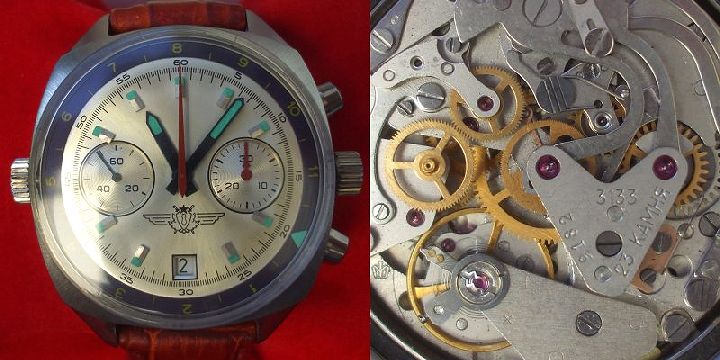
An early 5-digit serial number "04226" 1989:
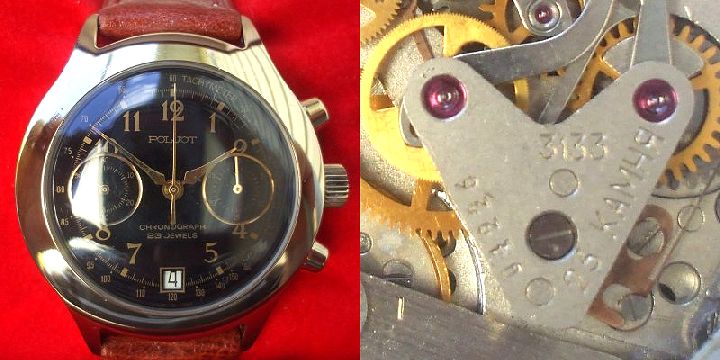
A complete bridge stamp overhaul took place in 1997 with a noticeable downsizing of the serial number font:
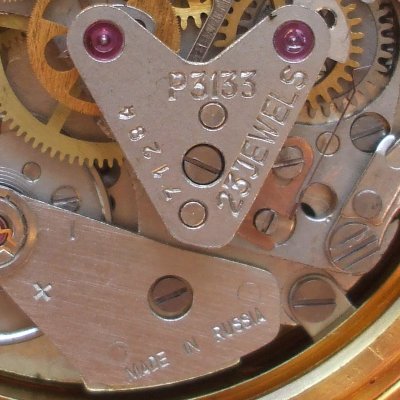
The Date Ring
The San Serif font on the early date ring prints is slightly bolder.
An early '80s aviator model sporting a replaced chrono second hand and crystal, a repaired second and chrono minute hand, and the original older date ring:
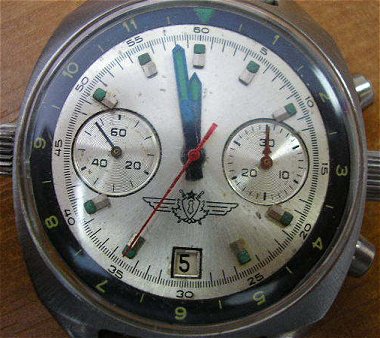
A mid-80s Aviator with a slightly more refined print of the same Sans Serif font on the date ring:
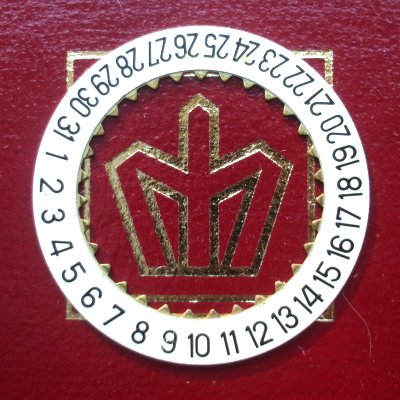
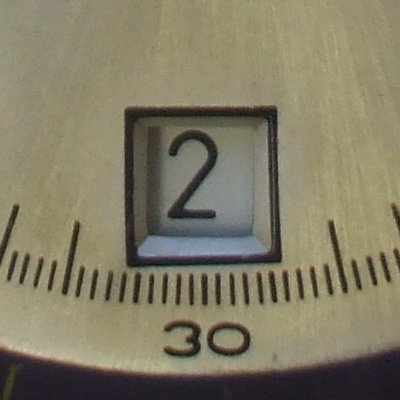
A new thin and tall Gothic-style font replaces the old Sans Serif date ring font in 1987:
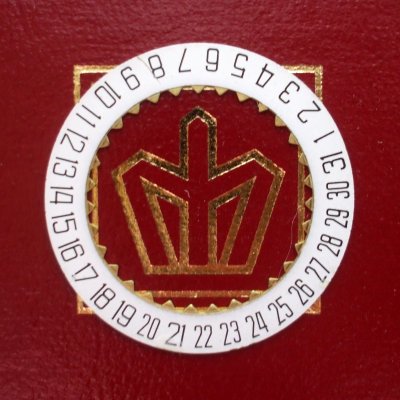
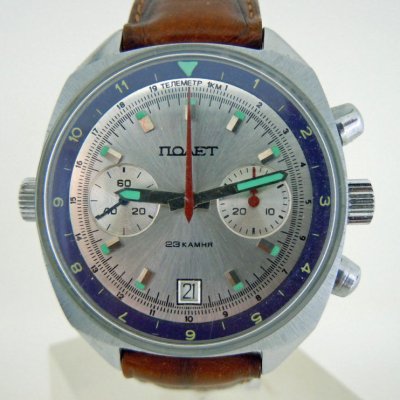
Over a decade later, just Prior to the demise of Poljot, a new and much bolder font made it's debut in 2001:
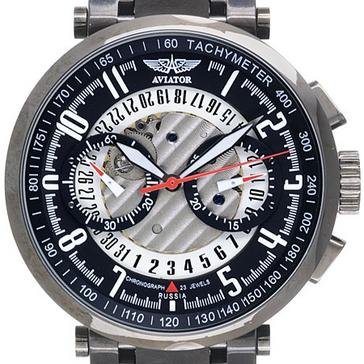
A new and very classy "Times Roman" style font also appears on many post-2000 date rings:
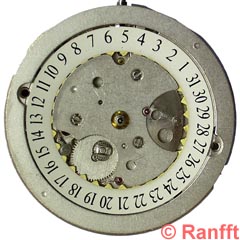
The Chronograph Reset Lever
Converted from a two-piece adjustable to one-piece non-adjustable between 1986-87. Another easy way to date your chronograph.

Dials, Bezels and Cases
To keep things manageable, I'm going to limit coverage to the late-seventies and majority of the eighties. Juri Levenberg’s numerous catalogues, available through his eBay store, adequately cover the hundreds of dials available throughout the nineties.
Documented history of the early Poljot 3133 chronographs is, to say the least, vague. According to numerous sources(all repeating the same thing), the military-issue OKEAH was produced first, followed shortly thereafter by the military-issue Aviator Sturmanskie, and then we jump ahead 5-years to the release of the 3133 movement for non-military use in 1983 - with nothing more than a few links to spaceflights for other pre-1983 models. Beyond 1983, however, you can find a much greater degree of information, mostly imagery, supplied by sources across the internet.
A quick reference timeline chart:
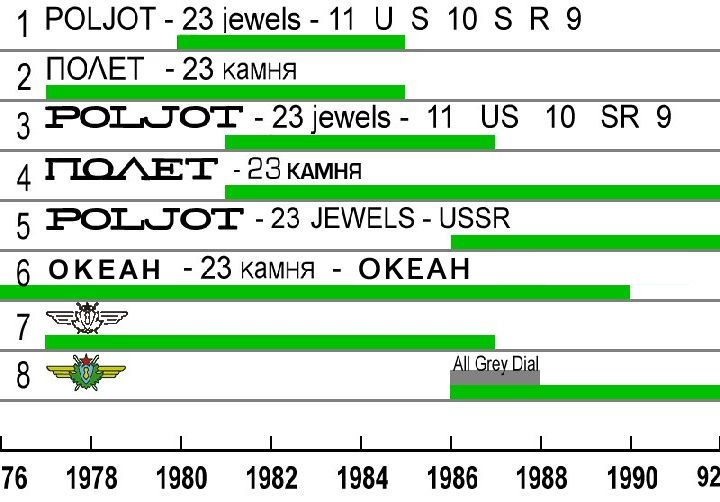
First, I'd like to touch on something all the chronograph dials have in common; the machining of the chronograph eyes. There are a few different variations. On the early dials, the ridge connecting the sunken chronograph eyes and the main face of the dial has a curved slope:
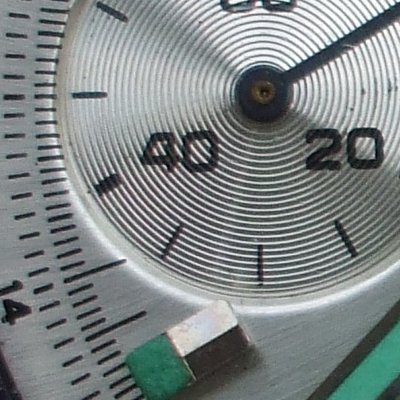
Note the slight curvature at the far end of the the painted indices adjacent to the chronograph eye.
Some mid-'80s dials had what looks to be a trench around the vertical walls that connect the sunken chronograph eyes and the main face of the dial:
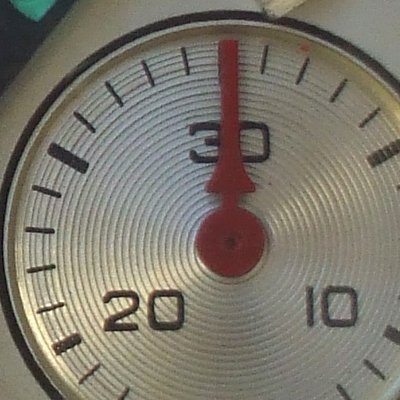
Later versions are simple straight cut right angles:
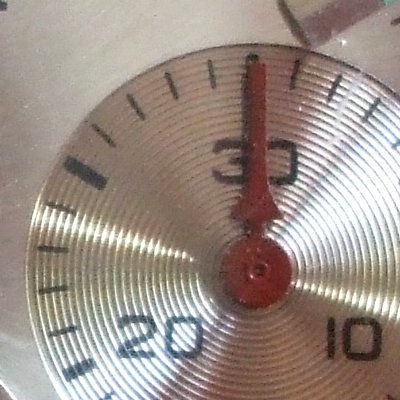
The so-called "Civilian" Dials

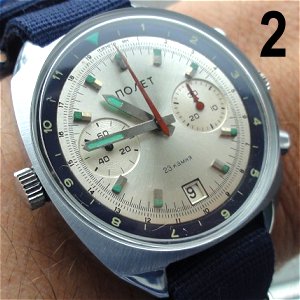
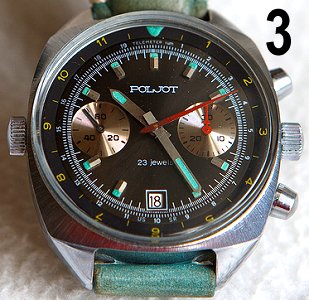
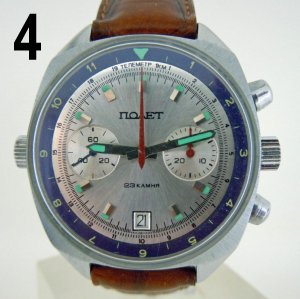
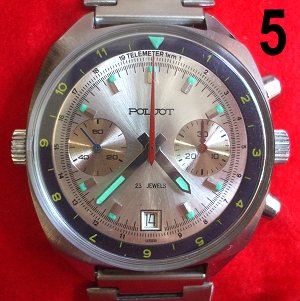
Not all of the colour variations (silver, black or blue) are listed.
A high-resolution scan of the chronograph(3) alleged to have been worn by Berezovoy on the T-5 Soyuz mission between May 13 - December 10, 1982:
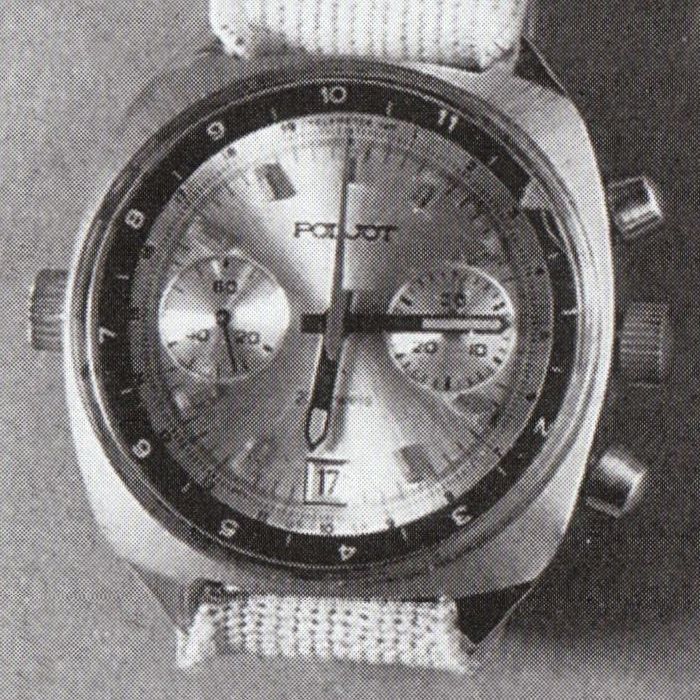
Serif-type fonts began to appear on Poljot chronographs ca. 1980.
Although it's clear that the dials with the Sans Serif font date back to the seventies, there is evidence to support both the San Serif dials, and the newer style dials with the slab Serif-type font, existed side by side through the early and mid-'80s:
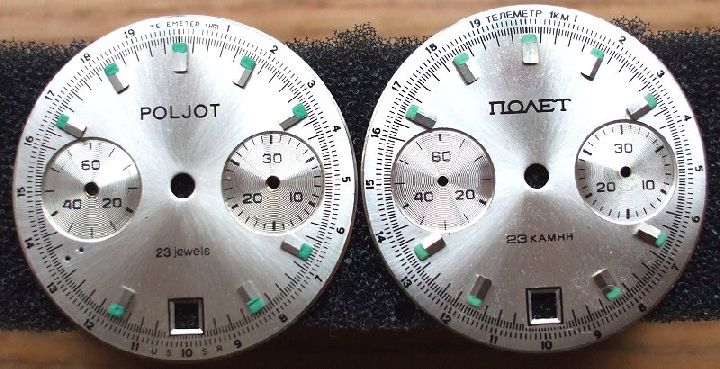
Almost identical dials.
The chronograph(2) in the centre of the image below is identical to the one alleged to have been worn by Gorbatko during the Soyuz 24 flight between February 7-25, 1977. Somehow, it made it's way into Poljot's 1992 catalogue. Unfortunately, I have no evidence to suggest that the older Sans Serif dials survived into the '90s. Therefore, I can only assume that (in the absence of an image of the newer model [i.e. with Serif-type font]) an older image from a previous catalogue was used in it’s place.
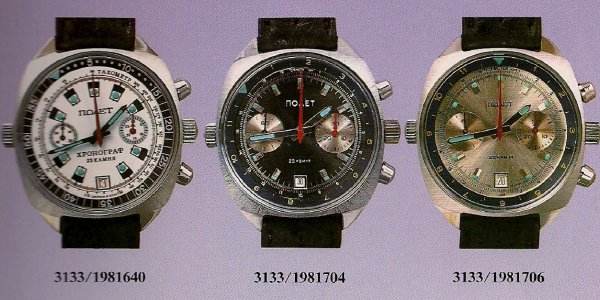
Note the positioning of the hands? For catalogue presentation, all Poljot watches had their hands positioned at 1:43. Also, notice the wrong hands on the model on the left, and the misaligned dial overlay! How did that make it to print?
OKEAH
One the most sought after Poljot Chronographs, limited production OKEAH chronographs from the late 1970s are almost non-existent, and original 1980s models are few and far between in today's online marketplaces.
The chronograph alleged to have been worn by Razhdestvensky on the Soyuz 23 mission between October 14-16, 1976:
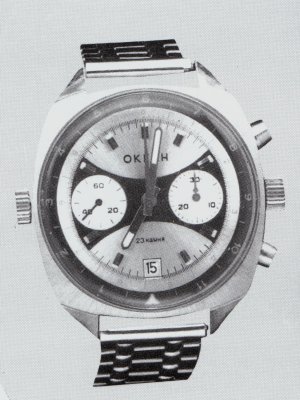
The one easily identifiable differences between the early(late-‘70s, early-‘80s) and late model Soviet era OKEAH dials is the slightly smaller font used to print the name "OKEAH" and the slightly off center horizontal line in the "H".
A picture taken from the official Volmax web site with the same small font:
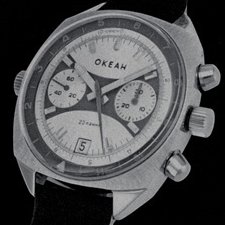
A Poljot catalogue image (probably from the early '80s) of an early OKEAH:
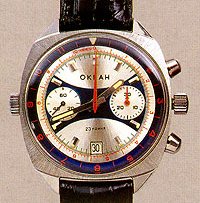
Again, for catalogue presentation, all Poljot watches had their hands positioned at 1:43. Also note the red time zone numbers on the rotating bezel, another indication of an early model.
And here is what I believe to be the definitive proof that this is the original OKEAH dial:
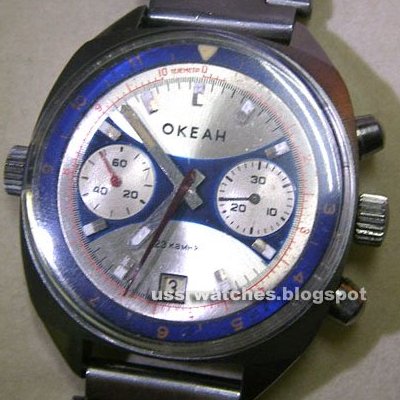
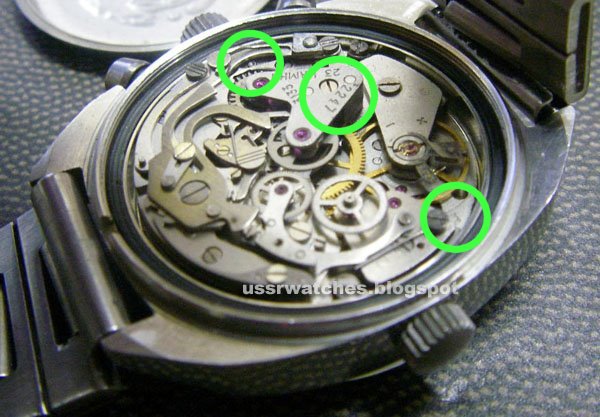
This watch has a early model of the original Poljot cal. 3133 movement with the solid head on the crown release button(see "Chronograph Bridge Stamps - Poljot Crown" above).
A mid-'80s OKEAH:
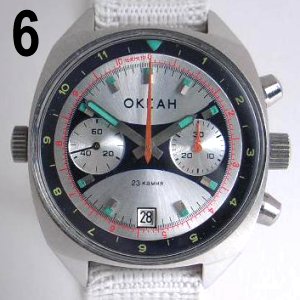
Military-issue OKEAHs have stainless steel cases. To date, I have no evidence of OKEAHs being produced into the nineties.
AVIATOR STURMANSKIES
Limited editions of the Aviator model were released up until it was replaced by the new grey painted version beginning in 1986. I own two of the older Aviator Sturmanskies. Both are fitted with stainless steel cases and stainless steel push buttons. I doubt this chronograph was ever available to the general public.
A mid-'80s Aviator Sturmanskie:
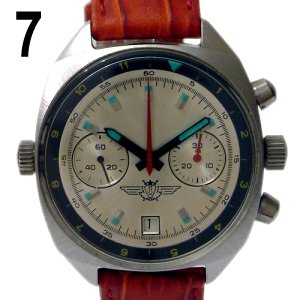
The early version of the new style stainless steel Aviator Sturmanskie 31569 - 1987:
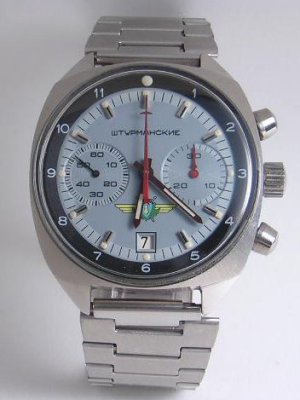
How do you tell whether on not the case is stainless steel? It's not that easy. Check for wear-through on the chronograph push buttons and back side of the case - not the actual screwed down case back which is stainless steel on all models. The screw down stainless steel case back is a good excuse for vendors to claim "Stainless Steel".
A late Soviet-era Sturmanskie 31569 and 3133 -1991:
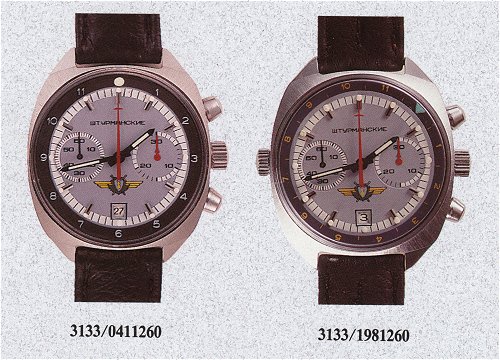
An excerpt from an early '90s Poljot catalogue: "During the latest Soviet-German space flight the new design of watch "Schturmanskie" was highly appreciated by spacemen."
An by modern-day collectors too! :-)
My late Soviet-era Sturmanskie:
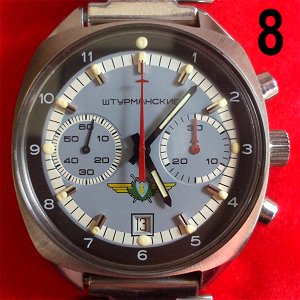
Replica Dials
There out there, so take a good look at the dial of any '80s chronograph before purchasing. The easiest way to tell if the dial is a reproduction is by checking for a contemporary application of luminance, as the colour, texture, and volume is way off.
